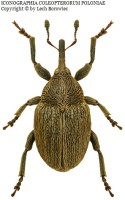Підтримуємо Вільну Україну
 We Support Free Ukraine
We Support Free Ukraine

Biodiversity Map
Taxa

-
Arthropodaphylum
Click to switch
to select orders
and filters > -
Hexapodasubphylum
Click to switch
to select orders
and filters > -
Insectaclass
Click to switch
to select orders
and filters > -
Coleopteraorder
Click to set
as the main taxon
and as a base
← of the left panel > -
Polyphagasuborder
Click to set
as the main taxon
and as a base
← of the left panel > -
Cucujiformiaseries
Click to set
as the main taxon
and as a base
← of the left panel > -
Curculionoideasuperfamily
Click to set
as the main taxon
and as a base
← of the left panel > -
Curculionidaefamily
Click to set
as the main taxon
and as a base
← of the left panel > -
Curculioninaesubfamily
Click to set
as the main taxon
and as a base
← of the left panel > -
Tychiinitribe
Click to set
as the main taxon
and as a base
← of the left panel > -
Sibiniagenus
Click to set
as the main taxon
and as a base
← of the left panel >
species:
Sibinia pellucens
PL
YES
name status: valid name
BioMap ID: 1046450
taxon code: 5310
taxonomy checked: YES
Data on distribution in Poland

Statistics
- Records: 310
- Publications: 75
- Collections: 10
- Publication authors: 63
- Illustrations (iconography): 1
- Photos (specimen/observation): 1
Taxon description
Obszar rozsiedlenia tego chrząszcza obejmuje południową, środkową i wschodnią Europę, Algierię, Maroko oraz Bliski Wschód. W Polsce, chociaż nie jest jeszcze znany z niektórych krain, występuje prawdopodobnie na całym obszarze z wyjątkiem wyższych partii górskich; większość jego stanowisk leży w pasie nizin i wyżyn. Występuje na polach, łąkach, pobrzeżach lasu i w zaroślach. Roślinami żywicielskimi są bniec biały — Melandrium album (Mill.) Garcke, bniec czerwony — M. rubrum (Weig.) Garcke i lepnica rozdęta — Silene inflata (Salisb.) Sm. Postacie dojrzałe po przezimowaniu pojawiają się na roślinach w maju i są spotykane do sierpnia. Samice w maju-lipcu składają jaja do torebek owocowych. Larwy żerują na nasionach. Przepoczwarczają się w torebkach owocowych. Nowe pokolenie ukazuje się we wrześniu.
Illustrations
... browse
 Sibinia
Sibiniapellucens
Photos
... browse
 Sibinia
Sibiniapellucens
External data sources
- Ostatnie rekordy
-
1099367
 ×
× Curculionidae: Sibinia pellucens, UA, Halicia, Cracovia, coll. IBL, Zakład Ochrony Lasu, Sękocin: Gottwald
Curculionidae: Sibinia pellucens, UA, Halicia, Cracovia, coll. IBL, Zakład Ochrony Lasu, Sękocin: Gottwald -
1060102
 ×
× Curculionidae: Sibinia pellucens, DE, Dom Esch, Kr.Euskierchen ad Bonn, 1998, leg. M. Mażewski
Curculionidae: Sibinia pellucens, DE, Dom Esch, Kr.Euskierchen ad Bonn, 1998, leg. M. Mażewski -
1027792
 ×
× Curculionidae: Sibinia pellucens, PL, Podlasie, Biebrzański P.N., podlaskie, Biebrzański P.N., Basen Południowy buffer zone, 1996, leg. M. Wanat (Wanat 2005d)
Curculionidae: Sibinia pellucens, PL, Podlasie, Biebrzański P.N., podlaskie, Biebrzański P.N., Basen Południowy buffer zone, 1996, leg. M. Wanat (Wanat 2005d) -
1027487
 ×
× Curculionidae: Sibinia pellucens, PL, Pojezierze Mazurskie, Biebrzański P.N., podlaskie, Biebrzański P.N., Basen Środkowy buffer zone, 1996, leg. M. Wanat (Wanat 2005d)
Curculionidae: Sibinia pellucens, PL, Pojezierze Mazurskie, Biebrzański P.N., podlaskie, Biebrzański P.N., Basen Środkowy buffer zone, 1996, leg. M. Wanat (Wanat 2005d) -
801949
 ×
× Curculionidae: Sibinia pellucens, PL (Mazur 2011c)
Curculionidae: Sibinia pellucens, PL (Mazur 2011c) -
801948
 ×
× Curculionidae: Sibinia pellucens, PL (Renner et Messutat 2007)
Curculionidae: Sibinia pellucens, PL (Renner et Messutat 2007) -
801947
 ×
× Curculionidae: Sibinia pellucens, PL (Knutelski et Sprick 2007)
Curculionidae: Sibinia pellucens, PL (Knutelski et Sprick 2007) -
801946
 ×
× Curculionidae: Sibinia pellucens, PL (Gosik 2006d)
Curculionidae: Sibinia pellucens, PL (Gosik 2006d) -
801945
 ×
× Curculionidae: Sibinia pellucens, PL (Mazur 2006d)
Curculionidae: Sibinia pellucens, PL (Mazur 2006d) -
801943
 ×
× Curculionidae: Sibinia pellucens, PL (Kuśka 2001d)
Curculionidae: Sibinia pellucens, PL (Kuśka 2001d) - ... more
- Powiązane publikacje
-
Mazur M.A. 2011c. Weevils (Coleoptera: Curculionoidea) of the Stobrawski Landscape Park. Pol. Pismo Ent., 80(2):321-342.
 full text
full text Show records
Show records -
Renner K., Messutat J. 2007. Untersuchungen zur Käferfauna der Umgebung von Skwierzyna im westlichen Polen (Wielkopolska). Coleo, 8:16-20.
 Show records
Show records -
Knutelski S., Sprick P. 2007. Report on weevil species collected in several regions of the Polish Western Carpathians in August 2004 (Coleoptera: Curculionoidea). Snudebiller, 8:245-258.
 Show records
Show records -
Mazur M.A. 2006d. Weevils (Coleoptera: Curculionoidea: Anthribidae, Apionidae, Curculionidae, Rhynchitidae) of selected excavations of Opole Silesia. [In:] Nowak A., Hebda G. (Eds.) Biodiversity of quarries and pits. Opole Scientific Society, 3rd Department of Natural Sciences, Opole-Górażdże. pp. 145-161.
 Show records
Show records -
Gosik R. 2006d. Weevils (Curculionoidea) of the middle part of the Bug River Valley. Ann. UMCS, C, 61:7-69.
 Show records
Show records - ... more
- Powiązane zbiory
-
ISEZ PAN
 Show records
Show records -
Kuśka A.*
 Show records
Show records -
Malkin B.*
 Show records
Show records -
Muz. Górnośląskie, Bytom: Mączyński
 Show records
Show records -
Wanat M.*
 Show records
Show records - ... more
- Wykaz powiązanych pozycji
-
Curculionoidea of Poland
 Show records
Show records





